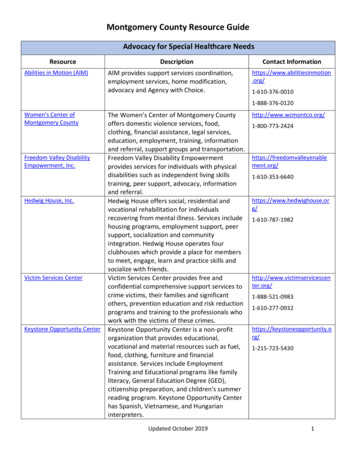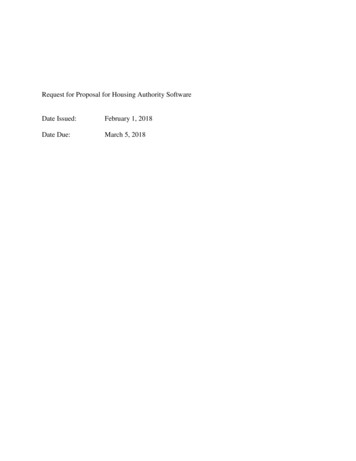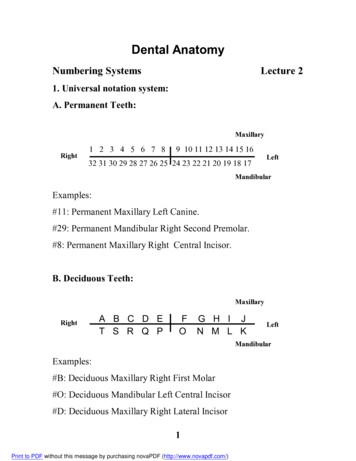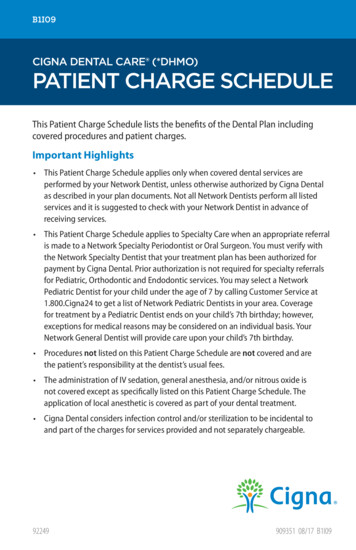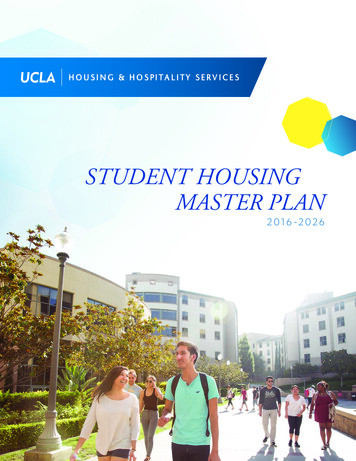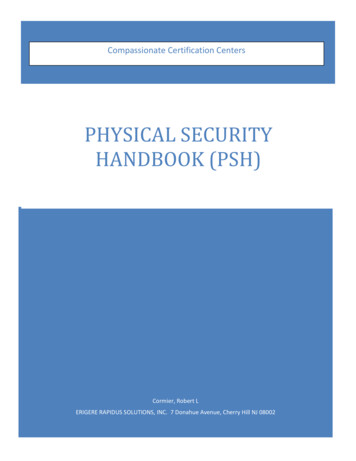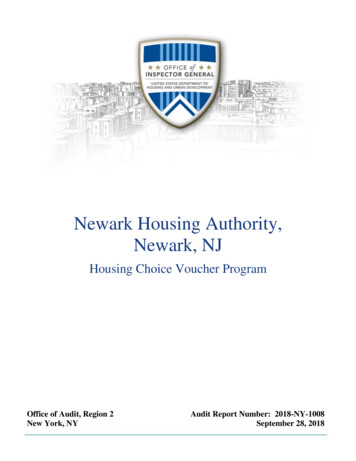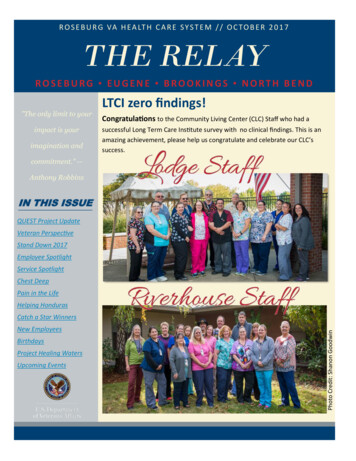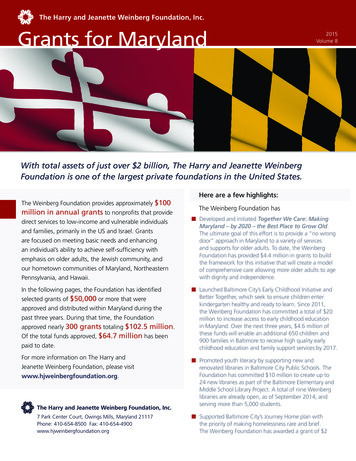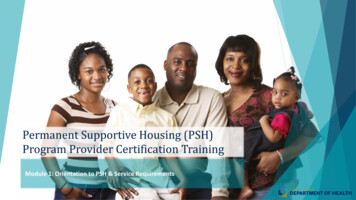
Transcription
Permanent Supportive Housing (PSH)Program Provider Certification TrainingModule 1: Orientation to PSH & Service Requirements
The Permanent Supportive Housing (PSH)ModelPart 1
Thank you for all that youdo!
What is Permanent Supportive Housing?
Evolution of Housing ModelsInstitution;Shelter;living onthe street24 odelsSupervisedsharedapartmentsettings
The Emergence of the PSH Model De-institutionalizationand the lack of adequate or sufficientcommunity support services No money for housing Growing criticism of a linear approach to residential models Effectiveness of Assertive Community Treatment (ACT) andIndependent Living Centers to meet needs in the community PSH emerged and combined a flexible array of services withaccess to decent, safe, affordable housing
PSH Core Principles Choice in housing Functional separation of housing and services Decent, safe and affordable housing Housing integration Rights of tenancy Housing access and privacy Flexible, voluntary recovery-focused services
PSH Works!Improved quality of life Housing stability and retention Improved health outcomes Reduced time spent homeless Reduction in use of emergency room Greater participation in mental health and substance abusetreatment Cost effective AND the more desired housing option
What makes PSH different from other housing programs?When people have the opportunity to live in housing of their choice,they generally do better. Balancingsuccess and satisfaction is an emphasis of services andsupport: Success in housing means being able to meet condition of lease:paying rent on time, not damaging the unit, being a good neighbor,etc. Satisfaction includes living in an apartment that meets personalcriteria: e.g. location, size, amenities, feeling safe and comfortable
The Louisiana PSH ProgramPart 2
So what does PSH look like in Louisiana?It’s consistent with the evidence-based PSH model. Affordable: tenant rent and utilities not exceeding 30% of individual’s monthlyincome; Offers assistance for access to and continued occupancy in housing as long astenant’s household pays the rent and complies with lease or applicablelandlord/tenant laws; Flexible and responsive supportive services are available, yet not mandated; Integrated within and meets HUD Housing Quality Standards; Functional separation of housing and services; Section 811 Project Rental Assistance in north Louisiana
Housing FirstLA committed to “housing first” approach in developing the PSHProgram. Housing First means housing is not contingent on certain conditions(e.g. clean & sober for x months) and supportive services are available,yet not required for obtaining or maintaining housing. Implementing a housing first approach: Requires staff skills in engagement, motivational enhancementtechniques; negotiation Common understanding across housing and services staff.
Housing First Quiz!For each question choose all answers that apply1. What must an individual do before receiving a permanent apartment?a) be clean and sober for 6 monthsb) agree to face-to-face visits with staffc) complete a transitional housing programd) none of the aboveb) agree to face-to-face visits with staff
Housing First Quiz!2. What should you do if a tenant is under threat of eviction?a) terminate servicesb) advocate for client, request reasonable accommodationc) continue to search for other housing optionsd) sue the propertyb) advocate for client, request reasonableaccommodationandc) continue to search for other housing options
Housing First Quiz!3. What should you do if you show up for a home visit and see drugparaphernalia on the table?a) call the landlordb) call the police or probation officerc) talk to the tenant about what you observed) terminate servicesc) talk to the tenant about what you observe
Rat Park Experiment“The opposite of addiction isn’t sobriety.It’s connection.”-Johann HariTypical rat cage in addiction experimentsRat Park cage with socialization and stimulation
How do individuals apply to PSH?Applicants might apply to PSH via their service provider, local continuum of care, orregional waiver office. The PSH application is public and available online, so anyone can apply. Applicationscannot be received in person.http://ldh.la.gov/psh1-844-698-9075 (PSH)1-844-756-1562 (811 PRA) The 811 PRA application can only be submitted from qualified referral sources. Takes about 30 days to process an application If eligible, individuals will be added to the waiting lists they selected. When individual comes to the top of the waiting list and there is a unit available, heor she will be system selected and referred to a PSH provider.
How does LA separate housing and services? Inkeeping with the model of PSH and the core principle ofseparation of housing and services, two statewide entities areinvolved in creating and managing the PSH Program:The Louisiana Department of Health (LDH) ServicesLouisiana Housing Authority (LHA) Housing
The LA Department of Health Services Officeof Behavioral Health (OBH) manages, either directly or through contract withthe 5 Healthy Louisiana Plans: MHR services (CPST/PSR) ACT services Officeof Aging and Adult Services (OAAS) manages: Community Choices Waiver, Long-Term Personal Care Services, Adult Day Healthcare CDBG-funded services via the PSH Program Office Residential nursing facility Officefor Citizens with Developmental Disabilities (OCDD) manages: Children’s Choice, New Opportunities Waiver, Support Waivers, Residential Options WaiverThe PSH Program Office coordinates the overall program across all LDH Program Offices, yet sits within theOAAS.
The Louisiana Housing Authority Housing Administers rental assistance payments Administers the Project Based Voucher (PBV) programManages Rental Assistance Contracts (RACs) for Section 811PRA Administers the Shelter Plus Care subsidies via contracts
Project Based Housing (PBV) Project-based means these vouchers are tied to the property and unit,and tenants cannot use them to rent another unit if they move. To obtain a PBV, individuals must apply to the PSH program and get onthe waiting list. Only eligible applicants who meet all criteria are placed on the waitlist:Very low- or extremely low-income Meet definition of “in need of PSH” Eligible for a Medicaid (MHR, ACT, OAAS/OCDD waiver) or Ryan White program
Continuum of Care (CoC) Formerly called Shelter Plus Care Has the additional criteria of homelessness. Five regionally based SPC Administrators have day-to-daymanagement responsibility. These subsidies are accessed through homeless serviceproviders and are based on vulnerability.
Continuum of Care Subsidy AdministratorsSubsidyAdministratorRegion CoC JurisdictionNumber of Contact InformationSubsidiesUnity of GreaterNew Orleans1Metropolitan Human ServiceAuthority / Jefferson ParishHSA875 tenantbasedMartha Kegel504-821-4496mkegel@unitygno.orgLouisiana HousingAuthority9Northlake Homeless CoC67 tenantbasedWinona Connor225-242-1389wconnor@lhc.la.govStart Corporation2Houma/Terrebonne CoC51 tenantbasedCasey Guidry985-879-3966casey@startcorp.orgLafayette CatholicService CenterIVAcadiana Regional Coalition on 23 tenantHomelessness and HousingbasedEric Gammons337-235-4972 ext 103egammons@catholicservice.orgCalcasieu ParishPolice JuryVLouisiana Balance of State CoC 23 tenantbasedUmeih Thomas337-721-4030 ext 5045uthomas@cppj.net
Section 811 Rental Assistance Contracts Operates like PBV Properties enter into a contract with LHATenants sign the Section 811 lease instead of the property’slease
PSH and Section 811 PRA Eligibility
Who Qualifies?Eligible individuals must meet ALL of the following criteria. Individuals who have a substantial, long-term disability: Serious mental illness Intellectual/Developmental disability Physical disability Disabling chronic health condition Disability must qualify for Medicaid-funded or other funded supports and services operated by LDHprogram offices of Behavioral Health, Developmental Disabilities, Public Health, or Aging and AdultServices, such as MHR (CPST/PSR), ACT, Community Choices Waiver, Residential Options Waiver or NewOpportunities Waiver Household must be financially eligible for the program (PSH: very low income, or 50% Area MedianIncome; 811: extremely low income, or 30% AMI) Qualifying household member must be in need of the supportive services offered by PSH.For Section 811 Project Rental Assistance, this individual must be between 18 and 61 years of age at time oflease signing.
What does “in need of PSH” mean?At least one member of the household must be “in need ofPSH” as defined by LDH. Household member’s physical, mental, or intellectual impairmentsubstantially impedes their ability to live independently withoutsupports. Their situation could be improved by more suitable housingconditions. They require the supportive services provided by PSH serviceproviders to retain that housing.
“In Need of PSH”– for example: Never Sometimes Often2. Needs support to maintain housing, includingassistance to access appropriate housingoptions; obtaining necessary documents andrecords to complete housing application orlease; obtaining/accessing sources of incomenecessary to pay rent, home management,establish credit; and understanding and meetingobligations of tenancy as defined in lease terms Never Sometimes Often3. Needs assistance to communicate with thelandlord or property manager regarding theapplicant’s disability, accommodations needed(wheelchair ramp, bath grab bars, etc.), neededrepairs, or other unit concerns Never Sometimes Often4. Needs assistance to communicate withneighbors (For example, resolving disputes in acalm manner)
Who gets preference?1. Individuals who are transitioning out of institutions2. Chronically homeless households3. Homeless households4. Households at risk of homelessness or inappropriateinstitutionalization5. Hurricane displacees (not for 811 PRA)
What happens after someone is foundineligible?Ineligible applicants will receive a denial letter in the mail aswell as information about how to appeal if they believe theirdenial is an error. 30 days to appeal Deniedagain; appeal conference
What happens after someone is found eligible? Eligibleapplicants are added to the waiting lists they selected. Eligible applicants will receive a letter in the mail with the waitinglists they selected, bedroom size, and any preference points theyreceived. There is no way of knowing how long someone will be on the waiting list,but applicants should notify our office of any changes in contactinformation while they wait so they can be contacted when they areselected for housing. PSH is not emergency housing – you may need to continue helping themlook for other housing resources.
Waitlist Period Activities for Applicants & dressPersonalRentalHistoryCreate ahousingback-upplan
Gather this Paperwork NowHousing Documentation Checklist Birth certificate (all household members) Valid Government Issued Photo ID (passport or state ID) - allhousehold members over age 18 Social Security card (all household members) Proof of citizenship/legal status (if applicable) Child Custody - Court documentation showing custody orguardianship Income documentation – no older than 60 days
What happens when they get to the top of thewaiting list? Whensomeone gets to the top of the waiting list AND there is aunit available, this is called system selected. At this time, we will verify eligibility, income, and need. If stilleligible and still in need of housing, applicant will be linked with aPSH-certified service provider. PSH supports get incorporated into the services the applicantalready receives. They may have two MHR providers, or theirwaiver budget will be amended to include PSH. Exception: Ryan White
Eligibility Pop Quiz . T/F : If a person receives a disability check, they are eligible.T/F: A person must be in need of PSH supportive services to beeligible. T/F: A person must be homeless or institutionalized to be eligible. T/F: A person has to pass a criminal background check to be eligible. T/F: Receiving Medicaid is not sufficient proof of eligibility. T/F: A person has to have an income to be eligible.
PSH Program Office: ManagementFunctions
Management & Delivery FunctionsLDH and LHA Outreach and Engagement Screening Services and Housing Referral Providing Services to Participants Tenant Services Management Tracking and Referral Meeting Performance Requirements as Established by LDH and LHA
Service Management (LDH)The LDH manages and monitors the services provided for PSHparticipants. Oversee application process and assist LHA with waiting listmanagement Monitor and certify PSH providers Manages housing referrals and transfer requests Program development Various service coordination
Tenant Services ManagersCurrently designated for Go Zone (South Louisiana) only. Primary contactbetween the service provider staff, the housing subsidyadministrators, and property managers. TSMs typically assist during periods of lapse inMedicaid coverage for MHRrecipients. TSMs can assist during system selection & Service provider assists with anyapplication at property if needed.challenges during tenancy, and reaches outto the TSM only when no resolution can be made and tenancy (new orcontinued) is jeopardized (see dispute resolution process).
Managing the ServicesThe Louisiana Department of Health houses thestate Medicaid office. 5 Healthy Louisiana plans under Medicaid manageMHR and ACT Services (CPST, PSR, CI) LDH OAAS/OCDD directly manages home- andcommunity-based waiver services
Housing Management (LHA) The LHA manages the PBV units and wait list in coordination with the PSH program office. Each time a new housing listing is posted, the LHA Housing Administrator will calculatethe number of days the PSH program office and referring agency has until the vacancymust be filled. Each prospective tenant, provider (including transition or care manager) will be providedwith a description of this process, with a break down of the recommended # of days foreach step to they can track the length of time needed to complete the process and fillthe vacancy. Administers rental payments Administers security / utility deposit assistance for 811 PRA.
Housing Management (LHA) The LHA contracts with and oversees CoC SubsidyAdministrators and issues guidance on requirements forreferrals, tenancy, waitlist management, and preferences.The CoC Administrator entities will communicate new andturnover units as soon as they become available, and willpost/advertise.
PSH Service Providers: What do you do?Part 3
Housing-Related Tasks for PSH Services Provider1. Housing Viewing and New Admission Paperwork2. Lease Signing and Move-in Assistance3. Housing Assessments4. Establishing and Modifying Service Plan Goals5. Providing services that promote successful tenancy, recovery and a satisfiedlife in the community6. Interim Reporting of Household and Income Changes7. Dispute Resolution
Housing Referrals: Service Providers Receive referrals from PSH Program officeMay make referrals for individuals currently being served who are eligible for oneof the Medicaid services and meet “in need of PSH” criteria Assist to submit PSH application Ensure paperwork is complete and obtain required documentation for newadmit packet Assure that assessments and authorizations for services are up to date Monitor status of PSH application and report changes in contact information Remain engaged with individual during application process
Identifying Housing, Leasing and Move-inAssistance Viewing apartments begins when the individual and service provider are notifiedthat they can begin this process and are referred to a particular propertyLimited timeframe to look at available units and make a decision. Service Provideris actively engaged in assisting person with this process. Provides transportation to available options if needed Assists with the decision making process Reviews and discusses terms of lease, present for lease signing Helps with arrangements for deposits, rental payments, arrearages Negotiates reasonable accommodations Assists with move, including packing, arranging for actual move, etc.
Identifying Tenant Screening BarriersEven though your client has been accepted by the PSH program, this does notmean he or she will automatically be accepted by the property. All properties have their own screening criteria. Landlords screen to reduce risk ofloss of income, neighbor disruptions or property damage. Be aware that you can usually request reasonable accommodation if your client isrejected at the property. Consider this part of the application process. Thingsto be aware of: Past evictions Credit history Criminal background
Reporting Household ChangesStay informed and assist individual to notify landlord of any of thefollowing changes: Household composition Income Requests not to renew lease Annual financial re-determination Re-certification process
Dispute ResolutionStay engaged with individual to avoid or minimize potential threats totenancy. Identify potential housing and tenancy barriers and address as part of the serviceplan Understand contributing factors: tenant, neighbor, property manager Assess potential conflict to determine if there is a lease violation Assist individual to understand options, consequences and problem solve how toresolve whenever possible Follow Dispute Resolution Process when unable to resolve
Dispute Resolution Process1st Level2nd Level3rd Level Issue identified and resolved between tenant andproperty manager and/or services provider Tenant, Services Provider and/or Property Managerdetermine issue not able to be resolved and housing is injeopardy TSM notified and attempts to resolve with Property Owneror PM Supervisor LDH PSH Program Manager and the LHC Housing AuthorityAdministrator attempt to resolve The LDH PSH Program Manager and LHC Housing AuthorityAdministrator jointly determine appropriate disputeresolution action
New Admit Packet for LHA A packet of release forms, identity information, and income verification Income verification documents can be no older than 60 days Complete assoon as individual is system selected; update income forms asneeded. Move-in packet for 811 PRA
Housing Based AssessmentAll MHR recipients need to have a behavioral health assessmentcompleted, but your agency might also have a separate one thatfocuses solely on housing. Housing-based assessments focus on: Housing-specific knowledge, skills and resources needed to choose, attain andmaintain housing Tenant screening barriers Personal criteria for housing (people, place, activities and resources directlyrelated to housing success and satisfaction)
Housing Based AssessmentsA good assessment focuses on strengths and needs and informs service activities andinterventions:Knowledge Whatdoes the person need to KNOW?Skills Whatdoes the person need to be able TO DO?Resources Whatdoes the person need to HAVE?
Housing Retention BarriersBarriers related to the applicant’s ability to understand and meet the conditions of thelease. Explicit expectations include payment of rent, upkeep of unit, meetingconditions of the lease, following rules of the property Implicit expectations include “fitting in” behaviors that contribute to beingconsidered a good neighbor and tenant. E.g.respecting neighbors ‘quiet enjoyment’ of property, understanding landlord-tenantrights and responsibilities Importantfor project based subsidies to assist person to understand the ‘culture’ ofthe building or complex
Responsibilities of TenancyPay Rent Budgeting and financial literacy and management Logistics: check or money order, where to pay rent, timelines (when do late feeskick in?)Maintain Apartment Meeting basic cleanliness standards Inspections Safety Managing repairs and maintenance requests
Responsibility of Tenancy“Quiet Enjoyment” Getting along with neighbors Visitors Noise Fitting in with communityOccupancy Only people on the lease live there
Tenancy Supports Regardless of the tenant’s disability, you are providingsupportive services to help them learn to role of a tenant.Some of our most important clinical tools in PSH aremotivational interviewing and harm reduction.
What is Motivational Interviewing?
What is Harm Reduction?
Housing Related PreferencesAlthough not always possible to accommodate, it’s important to beaware of aspects and features that contribute to satisfaction andenjoyment. People (neighbors, friends, landlord, support network, etc.)Place (characteristics of the actual housing setting, amenities)ActivitiesResourceWhen we don’t like where we live, we may act in ways that reflectthis and may jeopardize housing.
Incident ReportsKnow your agency’s policy (and PSH’s) on incidents that need to be reported and how tofile this report. Examples include: Death of tenant Abandonment of unit Severe injury inside of unit Major damage to unit Suspected child or elder abuse Suicide or homicide attempt Extended hospitalization
Establish and Modify Service Plan Goals Housing Goal is identified in individual’s Treatment/Service Plan Emphasizes delivery of services aimed at assisting the individual to gain theknowledge, skills and resources necessary for success and satisfaction in: Keeping housing by learning to be a good tenant; Improving mental, emotional, and physical health (this is about keeping housing, too!); Increasing overall quality of life. Developing the skills and supports needed to be a good tenant, neighbor, citizen,experience well-being and personal satisfaction. Develop Crisis Prevention and Intervention Plan for initial adjustment timeperiod (to be updated once the individual has settled in). Think about thosehousing retention barriers.
Key Tasks of PSH Phases
Phases of PSHPreTenancyMove-InOn-goingTenancy
Phases of PSHPretenancyMove-inOn-goingTenancy Starts at system selection Includes re-verification of eligibility (services) Applying at property, choosing a unit Understanding role of tenant Completing new admit packet Arrangement for actual move Ensuring unit & individual are ready for move in Initial adjustment to new home and neighborhood Sustained, successful tenancy Personal satisfaction: Relationships, employment/education, Flexing the type, intensity, frequency & duration of services based on needs & preferences
PSH unit(s)become availablePre-TenancyView available units and selectunit that is a good ‘match’Complete Ownerapplication process;await approval
“In my early professionals years I wasasking the question: How can I treat,or cure, or change this person? Now Iwould phrase the question in thisway: How can I provide a relationshipwhich this person may use for his ownpersonal growth?- Carl Rogers”
Pre-Tenancy ServicesEngagement, relationship building with emphasis on housing supportneeds and preferences. Begins with assessment of housing and service needs and ends whenhousing unit is selected and ready for move in.
Key Tasks Of Pre-tenancy Developingrapport and partnership Understanding/assistingwith PSH housing subsidy/ voucher andservice program eligibility as needed Understandingthe role and responsibilities of being a tenant
Key Tasks of Pre-Tenancy Assessing Planningstrengths, preferences, housing and tenant barriersfor support and service needs Conductinghousing ‘search’ and selecting a unit Completinghousing applications and awaiting approval Developinitial Crisis Prevention and Intervention Plan
Common Challenges Pre-Tenancy Difficulty in locating or staying engaged with the individual Lack of essential documentation needed for housing application Trouble selecting a unit or does not want unit that is available
Move-In Phase
Move-in Phase Many details to be arranged and attended to: Making sure the individual has funds for security deposits, utilities turned on,furniture and household set up Arranging for, or assisting with the actual move Assisting the person to pack and unpack belongings Lease signing Supporting the person through the move and initial adjustment Anticipating need for increased support
Key Tasks of Move-in Phase Arranging Assistingand/or assisting with actual move into the PSH unitwith packing and unpacking belongings Orientingto new neighborhood Providingincreased support during move and initial adjustment period
Common Challenges Move-In Last minute glitches with move in Disengagement What else?
On-going TenancyLife in the Community
On-Going Tenancy Fostering community integration & inclusion Community participation, good neighbor, citizenship Developing natural support networks Building friendships, peer support, reduced reliance on staff forsocial needs
On-Going TenancyProviding services in a flexible manner that responds to theindividual’s changing needs Adjusting frequency and intensity of services Avoiding ‘drive by’ case managementMoving from housing stabilization to thriving in thecommunity Employment, education, and meaningful activity Personal enrichment goals
Key Tasks of On-Going Tenancy Accessing Pursuingsocial and recreational opportunitiesemployment or education goals Engagement with Interveningexisting and/or creating new support networksearly in housing and landlord issues
Key Tasks of On-Going Tenancy Updatingassessment and service and crisis support plans to reflectcurrent needs and interests Skillbuilding to promote competence and self-sufficiency in managingapartment Servicelinkage and coordination Assistancewith treatment for health and behavioral health conditions
Common ChallengesOn-Going Tenancy Buyer’s remorse “Failure to thrive” Housingis jeopardized
Why Eviction MattersSource: Evictionlab.orgHow does an eviction affect someone’s life?Eviction causes a family to lose their home. They often are also expelled from theircommunity and their children have to switch schools. Families regularly lose theirpossessions, too, which are piled on the sidewalk or placed in storage, only to bereclaimed after paying a fee. A legal eviction comes with a court record, which canprevent families from relocating to decent housing in a safe neighborhood, becausemany landlords screen for recent evictions. Studies also show that eviction causes jobloss, as the stressful and drawn-out process of being forcibly expelled from a homecauses people to make mistakes at work and lose their job. Eviction also has been shownto affect people’s mental health: one study found that mothers who experiencedeviction reported higher rates of depression two years after their move. The evidencestrongly indicates that eviction is not just a condition of poverty, it is a cause of it.
The Eviction Epidemic: Matthew Desmond
Life After PSH For many, PSH is not the “end of the road.”Services must emphasize education, employment and othergoals that increase income and life satisfaction.
Promoting Successful Tenancy: ServicesAvailable to Individuals Living in PSHPart 4
Community-Based Services: Medicaid MentalHealth Rehab Services Community Psychiatric Support and Treatment (CPST) Psychosocial Rehabilitation (PSR) Crisis Intervention (CI) Assertive Community Treatment (ACT) WaiverServices Community Choices Waiver (OAAS) NOW, Children’s Choice, Supports, Residential Options Waiver (OCDD)
Community Based Services: Non-Medicaid CDBG only services Similar to MHR; only available to pre-approved individuals who have been ‘grandfathered’ intothe PSH Program. Not available for 811 PRA. Ryan White Services Approved through the Office of Public Health (OPH) for eligible individuals living with HIV/AIDS
Community Psychiatric Support & Treatment (CPST)
CPST
CPST
Psychosocial Rehabilitation (PSR)
PSR
Crisis Intervention
Crisis Intervention
Assertive Community Treatment (ACT)
ACT
ACT
Community Choices Waiver (CCW) Services
CCW: Housing Stabilization Services Enableswaiver participants to maintain their own housing as set forth in theparticipant’s approved plan of care (POC). Service isonly available: Upon referral from the Support Coordinator. Is not duplicative of other waiver services, including Support Coordination. To persons who are residing in a State of Louisiana PSH unit. Limited to no more than 72 units of HSS per year without written approval form the SupportCoordinator No more than 165 units of HSS and Housing Transition or Crisis Intervention can be used per yearwithout written approval from Support Coordinator
CCW: Housing Stabilization Services Components1.2.3.4.Participate in POC renewal and updates as needed, incorporating elementsof the housing support planProvide supports and interventions per the individualized housing supportplan.1. If additional supports are identified as needed and are outside thescope of Housing Stabilization Services, inform Support CoordinatorProvide on-going communication with the landlord or property managerregarding participant’s disability, accommodations needed, andcomponents of emergency procedures involving the landlord/PM.Update Housing Support Plan annually or as needed due to changes.
CCW: Housing Transition or Crisis Intervention Services Enableswaiver participants who are transitioning into a PSH unit,including those coming from institutions, to secure their own housing;or provide assistance at any time th
What makes PSH different from other housing programs? Balancing success and satisfaction is an emphasis of services and support: Success in housing means being able to meet condition of lease: paying rent on time, not damaging the unit, being a good neighbor, etc. Satisfaction includes living in an apartment that meets pers

